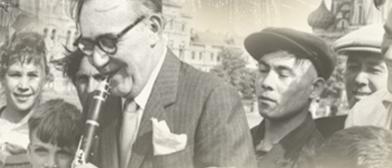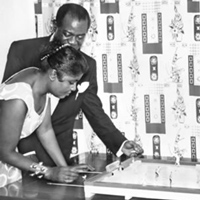
Accra, Gold Coast, 1956
This unofficial ambassadorial trip, sponsored by Edward R. Murrow and CBS, served as a model for Satchmo’s State Department tour of Africa in 1960-1961. Nkrumah was familiar with jazz music and Black American culture, having studied in the United States in the 1930s.
Courtesy of the Louis Armstrong House Museum. |
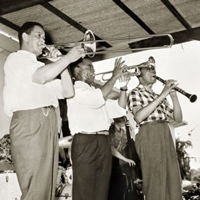
Louis flanked by Trummy Young (left) and Edmond Hall (right). Accra, Gold Coast, 1956
Local authorities panicked when a huge crowd arrived to hear the band. Waving his trumpet, Louis came on stage and called out, “Greetings all you cats!” before launching into his signature piece, When It’s Sleepy Time Down South. Journalists covering the event reported that “Satchmo [was] a smash.” At a later concert, Armstrong sang (What Did I Do To Be So) Black and Blue, and Edward R. Murrow’s CBS production crew captured a visibly moved Prime Minister Nkrumah on film.
Courtesy of the Louis Armstrong House Museum. |
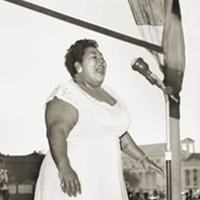
Louis with vocalist Velma Middleton. Accra, Gold Coast, 1956
Local authorities panicked when a huge crowd arrived to hear the band. Waving his trumpet, Louis came on stage and called out, “Greetings all you cats!” before launching into his signature piece, When It’s Sleepy Time Down South. Journalists covering the event reported that “Satchmo [was] a smash.” At a later concert, Armstrong sang (What Did I Do To Be So) Black and Blue, and Edward R. Murrow’s CBS production crew captured a visibly moved Prime Minister Nkrumah on film.
Courtesy of the Louis Armstrong House Museum. |
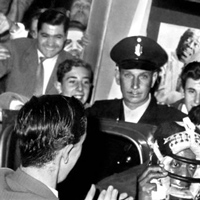
Buenos Aires, Argentina, 1957
This commercial trip to South America occurred in the wake of the Russian launch of Sputnik, the first satellite to orbit the earth. Concerned U.S. officials sent Air Force stunt fliers to local air shows to underscore America’s military prowess and this coincided with the Armstrong visit. The New York Times recognized the diplomatic value of the musician’s presence and reported that America was “pitting hot jet pilots and the hot jazz trumpet” of Satchmo against the USSR in a competition for world prestige and allegiance.
Courtesy of the Louis Armstrong House Museum. |
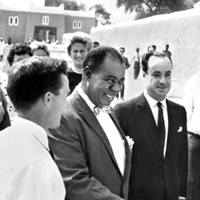
Louis meets Sir Ahmadu Bello, Sardauna of Sokoto and Premier of the Northern Nigerian Region. Kaduna, Nigeria, 1960
Pepsi-Cola partially sponsored the tour as part of its battle with Coca-Cola for ascendancy in the African soda market. In recognition of the band’s role in this competition, the U.S. jazz magazine Down Beat renamed them “Armstrong and his Pepsi Six.” His visit coincided with Nigeria’s independence celebrations.
Courtesy of the Louis Armstrong House Museum. |
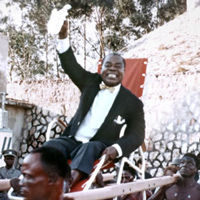
Leopoldville, Republic of the Congo, 1960
Louis was greeted in the Congo by joyous crowds, drummers, and dancers, and proudly recalled that he had stopped a civil war when a day-long truce was called so both sides could hear him perform. Local talents, inspired by the story of Okouka Lokole, a legendary figure with powers to charm wild beasts with his music, composed a song in Armstrong’s honor with the words: “They call you Satchmo, but to us you are Okouka Lokole.”
Courtesy of the Louis Armstrong House Museum, Jack Bradley Collection. |
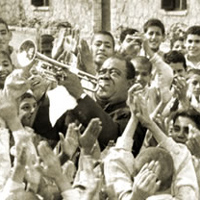
Cairo, Egypt, 1961
Louis had a special rapport with his youngest fans – visiting schools and playing for children in need while on tour.
Courtesy of the Louis Armstrong House Museum. |
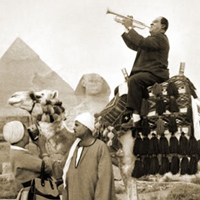
Giza, Egypt, 1961
The couple took a break from Satchmo’s grueling schedule to enjoy the majestic pyramids and the Sphinx. Louis struck a diplomatic high note in Cairo when he met Egyptian journalists from the Al-Ahram newspaper, along with officials from the U.S. Information Service.
Courtesy of the Louis Armstrong House Museum.
|
Satchmo Blows up the World
Louis Armstrong served in countless ways as America’s premier Jazz Ambassador, beginning with commercial tours to Europe in the 1930s and continuing throughout his life. In November 1955, just three weeks before the approval of the first government-sponsored jazz tour, Felix Belair, the New York Times correspondent in Stockholm, proclaimed that “America’s secret weapon is a blue note in a minor key . . .” and named Louis (Satchmo) Armstrong as “its most effective ambassador.” Given Louis’ skills at connecting with people of all backgrounds and cultures, Columbia Records producer George Avakian coined the sobriquet “Ambassador Satch.” From 1955 onward, wherever Armstrong traveled on official or unofficial trips, he was received as his country’s musical envoy.
Louis and his All Stars band made their first unofficial ambassadorial trip to the British Gold Coast in 1956, soon to become the newly independent nation of Ghana, where they were sponsored by Edward R. Murrow and CBS. When Armstrong was met by thirteen African bands perched atop trucks and playing and singing All For You, Louis, All For You!, he raised his trumpet and joined in. During this visit, Louis and the band thrilled a crowd of several hundred thousand, and were later serenaded by dancers, musicians, and drummers from every region of the country. One of the dancers resembled Armstrong’s mother, who had died twenty years earlier, leading the musician to declare, “I came from here, way back. At least my people did. Now I know this is my country too.” The U.S. consulate in Accra was thrilled by the band’s visit, and in official communiqués referred to the “outpouring of press and public enthusiasm.”
Negotiations were underway for Armstrong to perform in the USSR in 1957, a triumph for the State Department, but he abruptly cancelled these plans when the Little Rock school desegregation crisis went unresolved by the Eisenhower Administration. Satchmo’s candid remarks made front-page headlines – and underscored the value of the jazz tours to American Cold War diplomacy.
In October of 1960 Armstrong and the All Stars embarked on a three-month State Department tour around the African continent. He performed in twenty-seven cities, powerfully conveying his deep sense of connection to African peoples and their shared aspirations for freedom. In Leopoldville, in the Republic of the Congo, Louis was met by drummers and dancers and carried on a throne. The band subsequently appeared in Elisabethville in Katanga Province, leading Satchmo to comment that he had stopped a civil war when a day-long truce was called so both sides could hear them perform. Armstrong visited schools in West Africa and entertained children at a sanatorium in Cairo. The taxing schedule took its toll on the musicians. Singer Velma Middleton suffered a stroke and did not survive the trip. Armstrong was ordered by a physician to take a break because of fatigue, but instead ended up filming Paris Blues in the capital of France. The irrepressible Jazz Ambassador returned to Africa in January of 1961 for the final leg of the trip, which took the All Stars through Senegal, Mali, Sierra Leone, Liberia, Sudan, and the United Arab Republic.

